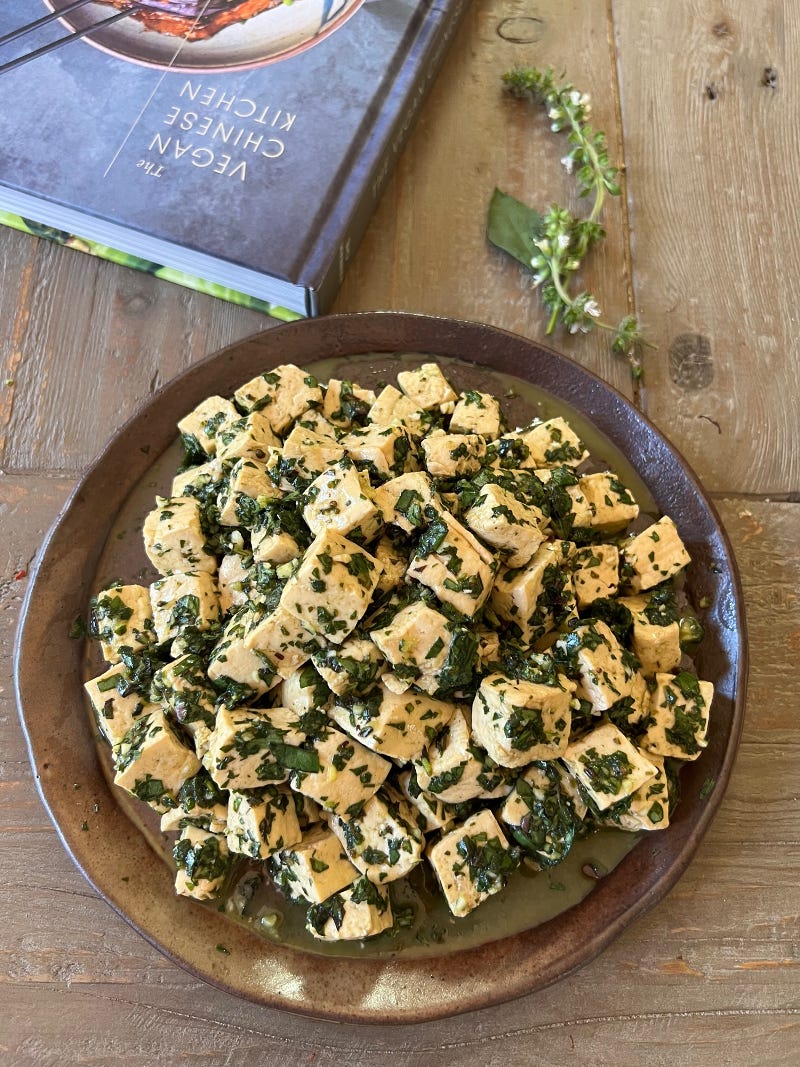MSG Deep Dive Pt 3: Fragrant Dressed Tofu with Basil and Garlic
Hannah Che's vegan recipe is perfect for playing with MSG and herbs
If you didn’t grow up seeing, tasting, and using monosodium glutamate (MSG) as a common kitchen seasoning, the flavor enhancing crystals can seem like some kind of illicit drug. It’s made from fermenting vegetables yet it’s a synthetic version of the glutamates originally extracted from kombu (dried kelp).
People don’t openly talk about using MSG like they would other transformative staples like say, pepper or sugar. In fact, in a near whisper, cooks have said to me, “There’s MSG in there.” (Wink.) Add to that, some Viet restaurants regularly put MSG in nuoc cham but it’s seldom publicly acknowledged. I interpret employing chicken bouillon powder or instant dashi in recipes as code for using MSG; most of those products contain the seasoning.
MSG is strangely secretive, though it is more present than we realize or want to acknowledge. We also want to understand it better.
What’s a MSG-curious cook to do if you want to start using MSG? You have to practice using it. When I first began using MSG in my cooking, I felt like I was cheating. Wasn’t my food tasty enough? Had I lost my touch? Was I using MSG as a flavor crutch? It’s easy to repudiate MSG because that’s been de rigeur for decades. But I asked myself this: In being hesitant or reluctant about using MSG, was I doing a disservice to my Asian culinary roots, which have been very well fed by MSG and other flavor enhancers? Yes. To be true, I need to explore and figure out how to use it well.
For the past few years, I’ve been honing my flavor enhancing skills to better understand MSG and its kin. Pho fans will benefit from an earlier conversation about MSG’s role in fine tuning the broth. Paid subscribers will have noted its use in recipes like the garlic crab-asparagus noodles and Viet Cajun seafood boil.
In my book, Ever-Green Vietnamese, I suggested MSG and other flavor enhancers as pivotal game changers for a handful of recipes, including vegan fish sauce (nước mắm chay) oven-fried imperial rolls (chả giò) and umami Q.P. mayonnaise (an easy dupe of Kewpie mayo!). Such recipes in the book need an extra flavor enhancing nudge to make them sparkle extra and express solidly good Viet flavors.
MSG Practice Recipe
Along with developing my own recipes, I learn from others. Keeping a beginner’s mind helps me to understand food and cooking better. To that end, looking for a recipe that combines MSG and summer’s bounty of fresh herbs, I began playing with a tofu recipe by Hannah Che from her James Beard award-winning book, The Vegan Chinese Cookbook. The recipe uses both salt and MSG along with a lot of fresh herbs to create a pesto-like sauce that coats tender tofu cubes. Below, the lemon basil imbues the tofu with its alluring lemongrass-y minty-ness.
Why MSG is Needed for this Tofu?
Like any protein, tofu naturally has glutamic acid. (In the 1930s, Ajinomoto used defatted soybeans to make MSG!) And just like any animal protein, tofu needs to be seasoned to express its full glory. In this recipe, salt, garlic, herbs, and sesame oil help the tofu sing but things don’t and won’t get delicious without a flavor enhancer. There’s just enough MSG to create good flavor but there’s not so much that you taste MSG (yes, MSG has a flavor and it will take over when it’s overused). You have to use it in cooking to realize how to ‘dose’ it. Vegan recipes are great for playing with MSG because you’re not dealing with any raw animal protein.
I’ve made this super simple, delicious recipe about half a dozen times and adapted Hannah’s recipe for my personal kitchen flow. Along with the recipe in text and pdf, I’ve written lots of tips and made a how-to video. I think you’ll enjoy tinkering with this tofu, which is so good and flexible that it’ll satisfy vegans, vegetarians and omnivores.





